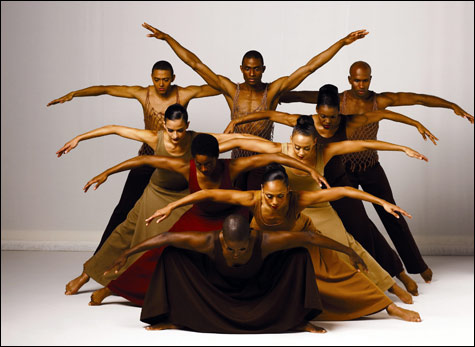
REVELATIONS: Forty-nine years later, it can still be revelatory. |
The last thing I had in mind when I went to the Opera House Tuesday was raining on Alvin Ailey's parade — particularly since the Alvin Ailey American Dance Theater, which he founded in 1959, is celebrating its 50th anniversary this year while making its 41st annual Celebrity Series appearance in Boston. All the same, I had more than one Huxtable moment during the first piece on the bill, the Boston premiere of Hope Boykin's 2008 Go in Grace. Performed to contemporary gospel music sung live on stage by Sweet Honey in the Rock, this was a paean to family values, with Father, Mother, Brother, and Little Girl, all in shades of orange, joined by two Boyz and the six members of Sweet Honey acting as a kind of Greek chorus. Brother wants to go out and hoof with the Boyz; Father's against that, even though what the Boyz are doing is pretty tame. Little Girl is daddy's little girl, and they have a sweet dance together, she standing on his toes, before the protective circle of Sweet Honey takes over to guide her through the stages of "Sweet Innocent Girl" and "Sweet Adolescent Girl" and "Sweet Teenage Girl." When Father dies, Brother dons his jacket and becomes the man of the family; Little Girl, meanwhile, overcomes her grief, grows up, and carries on, attracting the honorable attention of one of the Boyz at the end. What dancing there is in the midst of all the mime reads like an illustration of the "What brings us together and makes us belong" lyrics.
George Faison's 1971 Suite Otis was made as a tribute to Otis Redding, who had died four years earlier, with a score of six songs that he recorded. Granted, I'm no Otis expert, but it seems a little odd to have his music interpreted by guys in pink spandex. Pink is everywhere except in the opening "Just One More Day," where the bride wears black. In "Can't Turn You Loose," the girls swish their skirts, the guys chase them, the girls scream, and the guys break out in high kicks and other high jinks, the first real dancing of the evening. The couple in "My Lover's Prayer" start out sashaying cheek to cheek, but he can't keep his hands off the booty, so it's all break-up and make-up until he sweeps her off at the end. I didn't hear Otis sing "I can't get no girly action" during the Stones' "Satisfaction," but there was plenty of it from the six women on stage. "I've Been Loving You Too Long" is a succession of troubled duets by couples trying to deal with the title malady; "Try a Little Tenderness" is the upbeat remedy, the men spinning their ladies in the air as the curtain falls. The choreography looked generic, if not retro, and didn't seem to go with the music.

Ailey's signature Revelations, just a year younger than the company itself, will conclude every program in the Opera House run. These days, that's pretty much by popular demand, and it's not hard to see why: following Go in Grace and Suite Otis, the piece looked that much more muscular, volumetric, and rooted in the African-American experience, the ensemble of the opening "I Been 'Buked" speaking in tongues and luxuriating in the Light. The moments that spoke loudest Tuesday were the humble, solitary ones: Linda Celeste Sims and Glenn Allen Sims relating in a way that needed no fixing in "Fix Me, Jesus," Amos J. Machinic Jr. supporting a crushing burden of sin in "I Wanna Be Ready." The more communal celebrations, like the "Rocka My Soul in the Bosom of Abraham" finale, can seem impersonal when you flash back to the iconic, multi-winged bird of Revelations' opening tableau.
Every program will begin with the 12-minute film "Alvin Ailey American Dance Theater at 50." We see Ailey — who was born in 1931 in Rogers, Texas — as a boy in a cowboy outfit and brandishing six-shooters; we learn of his origins in the South, the blues, the gospel church; we get testimonials from Donald Byrd and Garth Fagan and Elisa Monte and Robert Battle. Best of all, there's Ailey himself, the force of his personality coming across even on film. The second half is more corporate, a plug for the company, for its Ailey II troupe, its Ailey Extension program, its Ailey Camp. Sweet Honey would sum all this up in a lyric about "how far we've come"; it might be a platitude, but it's also the truth.